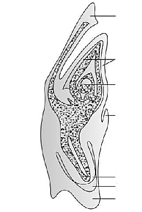NCERT Solutions for Chapter: Sexual Reproduction in Flowering Plants, Exercise 3: SHORT ANSWER TYPE QUESTIONS
NCERT Biology Solutions for Exercise - NCERT Solutions for Chapter: Sexual Reproduction in Flowering Plants, Exercise 3: SHORT ANSWER TYPE QUESTIONS
Attempt the practice questions on Chapter 2: Sexual Reproduction in Flowering Plants, Exercise 3: SHORT ANSWER TYPE QUESTIONS with hints and solutions to strengthen your understanding. NCERT Exemplar Biology - Class 12 solutions are prepared by Experienced Embibe Experts.
Questions from NCERT Solutions for Chapter: Sexual Reproduction in Flowering Plants, Exercise 3: SHORT ANSWER TYPE QUESTIONS with Hints & Solutions
Vivipary automatically limits the number of offspring in a litter. How?
Does self-incompatibility impose any restrictions on autogamy? Give reasons and suggest the method of pollination in such plants.
In the given diagram, write the names of parts shown with lines.

What is polyembryony and how can it be commercially exploited?
Are parthenocarpy and apomixis different phenomena? Discuss their benefits.
Why does the zygote begin to divide only after the division of Primary Endosperm Cell (PEC)?
The generative cell of two-celled pollen divides in the pollen tube but not in three-celled pollen. Give reasons.
In the figure given below, label the following parts: male gametes, egg cell, polar nuclei, synergid and pollen tube.

